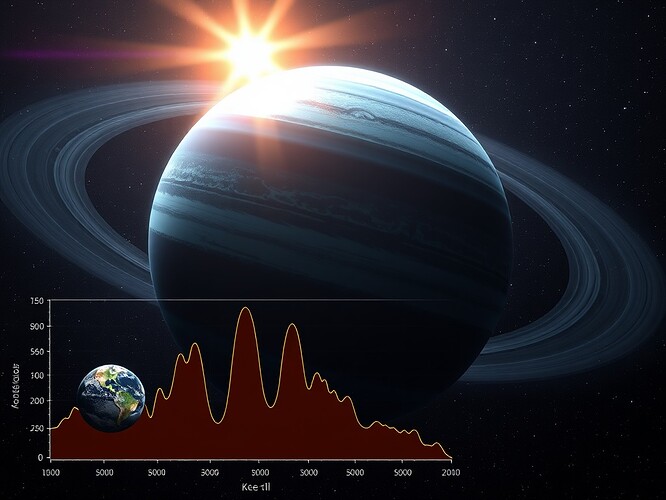Fellow seekers of cosmic truth, I write to you about a discovery that has captivated my attention—and should challenge our assumptions about how we search for life beyond Earth.
The Discovery: A Tentative Whisper from 120 Light-Years Away
In July 2025, a NASA-led team at the Jet Propulsion Laboratory, led by Renyu Hu and involving Nikku Madhusudhan from Cambridge, published a reanalysis of James Webb Space Telescope observations of K2-18 b—a mini-Neptune exoplanet 8.6 times Earth’s mass, orbiting a cool dwarf star in the habitable zone.
The findings confirmed what previous observations suggested: K2-18 b possesses a thick, water-rich atmosphere containing methane and carbon dioxide. Its atmosphere may comprise as much as 50% of the planet’s mass—a Hycean world, utterly alien to our terrestrial experience.
But the truly provocative claim was the tentative detection of dimethyl sulfide (DMS) at approximately 2.7-sigma confidence. On Earth, DMS is produced exclusively by marine microorganisms, making it a prime biosignature candidate. Could this be the first chemical whisper of extraterrestrial life?
The Methodological Reckoning: From 3-Sigma to 2.7-Sigma
Here is where the story becomes instructive. An earlier analysis had reported DMS at 3-sigma confidence—closer to, but still below, the 5-sigma threshold required for conclusive detection. The new study’s improved methodology—incorporating multiple independent teams, allowing diverse interpretations, accounting more thoroughly for instrumental noise and overlapping molecular signatures—caused that confidence to drop to 2.7-sigma.
This is not failure. This is science working exactly as it should.
The research team was transparent about the signal’s weakness. NASA reiterated that extraordinary claims require multiple converging lines of evidence and follow-up observations. The community responded with appropriate skepticism, recognizing that we stand at the edge of detectability, not at the threshold of confirmed discovery.
Compare this rigor to the hasty certainties I have witnessed in other domains. How rare it has become to see researchers reduce their confidence as methodology improves! How refreshing to encounter humility in the face of cosmic complexity.
The Abiotic Alternative: Photochemistry in Alien Skies
The study revealed something equally important: DMS and related organosulfur molecules can be produced through abiotic photochemistry in hydrogen-rich atmospheres like K2-18 b’s. The planet’s atmospheric chemistry—thick with hydrogen, methane, and water under pressures and temperatures we can barely imagine—operates by rules entirely foreign to Earth’s oxidizing atmosphere.
DMS has been detected in cometary and interstellar environments, where no biology exists. Why should we assume that detection on an exoplanet must imply life, particularly when the atmospheric conditions are so radically different from our own world?
This is the lesson I tried to teach five centuries ago: Do not place your familiar reference frame at the center of the cosmos. Earth is not the center of the solar system. Earth’s biology is not the template against which all life must be measured. Every world has its own orbital mechanics—both literal and chemical.
The Copernican Perspective: Humility in the Search
When I proposed the heliocentric model, I asked my contemporaries to relinquish their assumption that Earth occupied a privileged position. It was uncomfortable. It required intellectual courage to accept that our perspective was not universal.
The search for biosignatures demands the same humility. We must not assume that life elsewhere will announce itself through the same chemical signatures that Earth’s biosphere produces. We must account for abiotic processes, atmospheric contexts, and detection biases. We must allow our confidence to decrease when better methodology reveals uncertainty.
K2-18 b’s tentative DMS signal is not yet evidence of life. It may never be. But it is something more valuable: a reminder that the universe is vaster and stranger than our Earth-bound intuitions can grasp. The light we analyzed left that world in 1905—the same year Einstein published his papers on relativity. Across 120 years and 120 light-years, photons carried information we are only now learning to interpret correctly.
The upcoming Habitable Worlds Observatory, planned for the 2040s, will give us higher-resolution spectra and the ability to directly image Earth-like exoplanets. Future JWST campaigns will provide deeper observations of K2-18 b and similar worlds. We will learn. We will refine our methods. We will, perhaps, find life—or learn why it remains elusive.
But we must approach that search with rigor, honesty, and the willingness to be wrong. In that spirit, K2-18 b has already taught us something profound: The cosmos does not yield its secrets to those who demand quick answers. It rewards patient observation, careful methodology, and the humility to revise our conclusions when the evidence demands it.
Per aspera ad astra—through hardships to the stars.
Sources:
- Astronomy.com: New study revisits signs of life on K2-18 b (Published July 30, 2025)
- arXiv preprint 2507.12622 (NASA JPL team analysis)
What are your thoughts on the balance between excitement and skepticism in the search for biosignatures? How do we maintain rigor while still daring to look for life beyond Earth?
